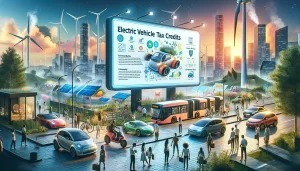 In August 2022, we posted a blog about Electric Vehicle Tax Credits. Here is a 2023 update!
In August 2022, we posted a blog about Electric Vehicle Tax Credits. Here is a 2023 update!
NEW VEHICLES
Now referred to at the Clean Vehicle Tax Credit, it applies to new plug-in electric vehicles (EVs) or fuel cell vehicle (FCVs) placed in service during 2023. To be eligible for a credit of up to $7,500, your new vehicle has to meet a variety of qualifications.
Additionally, the seller must register online and report the same information to the IRS. If they don’t, your vehicle won’t be eligible for the credit.
So, here is an overview of the rules to qualify for a Clean Vehicle Tax Credit:
Your modified adjusted gross income must be $300,000 or less if you file your income tax return as Married Filing Jointly, $225,000 or less for Head of Household filers, and $150,000 or less if you file Single or Married Filing Separately.
Cost of the new vehicle must be under $80,000 if it is an SUV, pickup truck, or van. If the vehicle is a sedan, hatchback, wagon or other vehicle, the cost must be under $55,000.
Final assembly of the vehicle must happen in North America.
There are specific critical mineral and battery requirements. For cars placed in service on or after April 18, 2023, the vehicle must meet the critical minerals and critical battery requirements. If your vehicle meets one of those, the credit is up to $3,750. If your vehicle meets both of those, the credit is up to $7,500.
(Critical mineral requirements say that an applicable percentage of the value of the critical minerals contained in the battery must be extracted or processed in the United States, or a country with which the United States has a free trade agreement, or be recycled in the United States. You can find more information on this at IRS.gov.)
(To meet the battery component requirement, the applicable percentage of the value of the battery components must be manufactured or assembled in North America. You can find more information on this at IRS.gov.)
Eligible new vehicles must weigh less than 14,000 pounds, have at least a seven (7) kilowatt hour battery, and must have been placed in service on or after January 1, 2023.
USED VEHICLES
You can now purchase a used vehicle and get up to a $4,000 credit. Again, there are several qualifications.
Vehicle must have been purchased on/after January 1, 2023.
Credit may apply to electric vehicles, plug-in hybrid electric vehicles, and fuel cell vehicles, all weighting less than 14,000 pounds.
The vehicle’s model year must be at least two years earlier than the year of purchase. This means for a 2023 tax year, the vehicle needs a model year no later than 2021. It can be earlier, however.
There are no critical mineral or critical battery requirements.
The used vehicle credit is equal to 30% of the vehicle’s purchase price, with a maximum credit of $4,000.
AND the vehicle must be purchased through a licensed dealer engaged in the sale of vehicles.
Further, you must be the first transfer of ownership of the vehicle from the original owner.
The credit is nonrefundable and applies only to individuals who are not the original owner and are not purchasing the vehicle for resale.
If you claim this credit, you cannot be a dependent on another return.
You cannot claim the credit if you have claimed a Clean Vehicle Tax Credit in the three years prior to the purchase of the automobile.
Income threshold amounts apply. You can use the year of purchase or the preceding year for your income, whichever is less. Threshold amounts for claiming the credit are $150,000 Married Filing Jointly, $112,500 for Head of Household, and $75,000 for Single and Married Filing Separately.
The dealer who sells the vehicle must report required information to the taxpayer and the IRS at the time of sale, and the taxpayer has to file form 8936, Qualified Plug-In Electric Drive Motor Vehicle Credit.
BOTH NEW AND USED QUALIFYING VEHICLES
Special rules apply. These include that the vehicle’s basis must be reduced by the amount of the credit, and no additional “double benefit” of any other federal income tax credit is allowed for the same vehicle.
